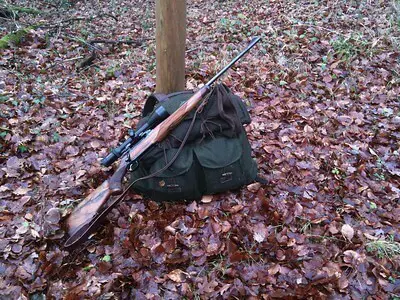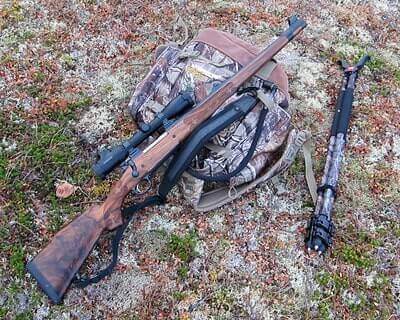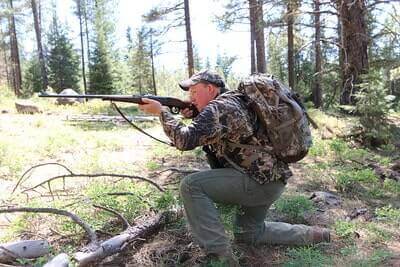Disclosure: We may earn commissions if you purchase products after clicking on a link from our site.
If you’re a hunter, then you know that a good scope is crucial to your success. A quality scope will help you hit your target every time, no matter how far away it is. If you’re new to hunting, or if you’ve never mounted a scope on your rifle before, don’t worry – we’re here to help! In this blog post, we give the steps on how to mount a scope on your rifle like a pro.

Table of Contents
How To Mount A Scope On Your Rifle
1. Remove the Bolt Or Action
Removing the bolt or action from the rifle is a crucial step when mounting a scope as it provides easier access to the receiver for proper installation. Removing the bolt or action, allows the shooter to have a clear view and access to the mounting holes on the receiver.
This makes it easier to align the scope rings or base with precision, ensuring that the scope is securely attached and properly aligned with the bore of the rifle.
Additionally, removing the bolt or action minimizes the risk of damaging the rifle or the scope during the mounting process, as it eliminates any potential interference or obstructions. Therefore, taking the time to remove the bolt or action before mounting the scope is a recommended practice to ensure a successful and hassle-free installation.
2. Choose Scope Mounting Hardware
Choosing the appropriate scope mounting hardware is a crucial step in the process of mounting a scope on your rifle. It involves selecting the right scope rings, bases, or mounts that are compatible with both your rifle and the scope you intend to mount.
Factors to consider when choosing mounting hardware include the type of rifle action (e.g., bolt-action, semi-automatic), the diameter of the scope tube, the height of the scope rings relative to the rifle’s bore, and the material and quality of the mounting hardware. It’s essential to ensure that the mounting hardware provides a secure and stable platform for the scope, preventing any movement or shifting during recoil.
Additionally, selecting high-quality mounting hardware that matches the specifications of your rifle and scope will contribute to better accuracy and overall performance when shooting. Taking the time to research and choose the right mounting hardware will ultimately result in a successful and reliable scope mounting process.
A. Scope/Ring Set Up
This setup consists of a “base” and a scope ring that screws into the base. This is the most basic and common setup. It is also the lightest setup.

B. Rail/Scope Ring Setup
It consists of a single rail that mounts into the barrel of the gun. The scope rings are then attached to the rail. With the rail/scope ring setup, it is mounted on the same plane which means the scope rings will also be mounted on the same plane.
This ensures that the scope rings are aligned and not torquing the scope at different angles. The only downside to the rail and scope ring setup is that it weighs a little bit more.
Make sure the mounting system you choose is the right fit for your hunting rifle. Also, make sure that the rings have the right diameter and height to properly position the scope.
3. Set the Scope
Setting the scope is a critical step in the process of mounting a scope on your rifle. Once you have selected and installed the appropriate mounting hardware, the next step is to properly position and align the scope of the rifle. This involves adjusting the eye relief, which is the distance between your eye and the scope’s eyepiece, to ensure a comfortable and clear sight picture.
Additionally, you’ll need to level the scope both horizontally and vertically using a scope leveling tool or a bubble level. Properly leveling the scope helps ensure that the crosshairs are aligned perfectly with the rifle’s bore axis, minimizing any potential for error in shot placement.
Once the scope is positioned correctly, it’s essential to securely tighten all mounting hardware to prevent any movement or shifting during recoil. Taking the time to set the scope properly will result in improved accuracy and consistency when shooting, enhancing your overall shooting experience.
4. Level the Rifle
Leveling the rifle is a crucial step in the process of mounting a scope on your rifle. Before attaching the scope, it’s essential to ensure that the rifle is perfectly level both horizontally and vertically. This ensures that the scope’s reticle will be aligned precisely with the bore axis of the rifle, minimizing any potential for error in shot placement.
To achieve proper leveling, a rifle vise or gun rest can be used to securely hold the rifle in place. A bubble level or scope leveling tool can then be placed on the rifle’s action or receiver to check for horizontal alignment.
Additionally, a separate bubble level or plumb line can be used to check for vertical alignment along the rifle’s barrel or receiver. Making sure the rifle is leveled before mounting the scope helps maintain accuracy and consistency in shooting, ensuring that each shot lands precisely where intended.

5. Align Reticle
Aligning the reticle is a critical step when mounting a scope on your rifle to ensure accurate shooting. Once the scope is securely mounted and leveled on the rifle, the reticle needs to be aligned with the rifle’s bore axis.
This alignment ensures that the point of aim matches the point of impact at the desired distance. To align the reticle, shooters can use a boresighting tool or a laser boresighter. These tools project a laser beam down the rifle’s bore, allowing the reticle to be adjusted until it aligns with the laser’s point of impact on a target.
Alternatively, shooters can perform a visual alignment by looking through the scope and adjusting the windage and elevation turrets until the reticle aligns with a distant, stationary object, such as a target or distant landmark. Properly aligning the reticle ensures that shots will be consistently accurate and on target, improving overall shooting performance. The best red dot scopes were reviewed in this article and you can read it from this link.
6. Adjust Eye Relief
Adjusting eye relief is an essential step when mounting a scope on your rifle to ensure optimal comfort and performance. Eye relief refers to the distance between the shooter’s eye and the ocular lens of the scope, where the shooter can see a full, clear-sight picture without experiencing any black rings or shadows.
To adjust eye relief, shooters need to mount the scope in a position that allows them to achieve the proper distance comfortably. This involves sliding the scope forward or backward along the rifle’s rail or mounts until the desired eye relief is achieved. It’s crucial to find the right balance between eye relief and proper sight alignment to maximize shooting comfort and accuracy.
Additionally, adjusting eye relief can help prevent eye strain and recoil-related injuries during extended shooting sessions. Once the optimal eye relief is achieved, shooters can secure the scope in place to ensure it remains in the correct position during use.
7. Bore Sight
Using a bore sight is a crucial step when mounting a scope on your rifle, aiding in aligning the scope with the barrel to ensure accuracy. A bore sight is a tool designed to help shooters align their scope’s reticle with the rifle’s bore axis before zeroing in at the shooting range.
To use a bore sight, shooters insert it into the rifle’s chamber or barrel, allowing the bore sight’s laser to project a visible point of aim onto a target placed downrange. By adjusting the scope’s windage and elevation settings to center the reticle on the projected point, shooters can achieve a rough alignment between the scope and the rifle’s bore.
While a bore sight won’t zero the rifle, it provides an initial reference point for adjustments, saving time and ammunition during the zeroing process. Bore sighting is especially useful when mounting scopes on bolt-action rifles or firearms with fixed sights, ensuring a more straightforward and accurate zeroing process later on.

Tools Of The Trade
Some tools will be needed to mount the scope on the rifle. It is always good to check the user’s manual to ensure you have all of the tools to get the job done.
1. Torque Wrench
A torque wrench is an indispensable tool for mounting a scope on your rifle, ensuring precise and uniform tightening of mounting screws to prevent damage to the scope or the rifle. When mounting a scope, it’s crucial to apply the correct amount of torque to the mounting screws to secure the scope firmly in place without over-tightening, which can lead to stripped threads or distortion of the scope tube.
A torque wrench allows shooters to apply specific torque settings recommended by the scope manufacturer, ensuring consistency and accuracy across all mounting screws. This helps maintain the scope’s alignment and integrity, reducing the risk of shifts in zero or damage during recoil. By using a torque wrench, shooters can achieve optimal mounting tension, enhancing the reliability and longevity of their rifle-scope setup while minimizing the likelihood of performance issues in the field.
2. Leveling Kit
A leveling kit is an essential tool for mounting a scope on your rifle, ensuring that the scope is perfectly aligned with the rifle’s bore axis. Proper alignment is critical for accuracy, as it prevents issues such as canting, which can lead to horizontal bullet deviation at longer distances.
A leveling kit typically consists of a bubble level that attaches to the rifle’s receiver or scope rail, providing a visual reference for ensuring the rifle is level both horizontally and vertically. By using a leveling kit, shooters can eliminate any potential misalignment between the rifle and the scope, resulting in more precise and consistent shot placement.
This tool is particularly valuable when mounting scopes with elevation turrets or long-range optics, where even slight misalignments can have a significant impact on accuracy. Overall, a leveling kit is an indispensable accessory for any shooter looking to achieve optimal performance from their rifle-scope setup.
3. Gun Stabilizer
A gun stabilizer is a valuable tool for mounting a scope on your rifle, aiding in maintaining stability and reducing movement during the mounting process. It provides a secure platform for resting the rifle, minimizing the risk of accidental shifts or vibrations that could affect the alignment of the scope.
By stabilizing the rifle, shooters can ensure greater precision and accuracy when adjusting and securing the scope in place. This is particularly important for long-range shooting or when mounting high-powered optics, where even slight movements can have a significant impact on zeroing and overall performance.
Additionally, a gun stabilizer can help reduce fatigue during the mounting process by providing comfortable and steady support for the rifle, allowing shooters to focus on achieving the perfect alignment of their scope. Overall, using a gun stabilizer as part of the scope mounting process can help shooters achieve optimal accuracy and performance from their rifle-scope setup.
4. Screwdriver
A screwdriver is an essential tool for mounting a scope on your rifle, allowing you to securely attach the scope rings or bases to the rifle’s receiver. It enables you to tighten and loosen screws with precision, ensuring that the scope is properly secured to the rifle.
When mounting a scope, it’s crucial to use the correct size and type of screwdriver to match the screws on your scope rings or bases. Using the wrong size or type of screwdriver can lead to stripped screws or damage to the mounting hardware, compromising the stability and alignment of the scope.
Additionally, some scopes may come with specific torque specifications for the mounting screws, and a torque screwdriver may be necessary to ensure proper tightening according to manufacturer recommendations. Overall, a screwdriver is an indispensable tool for mounting a scope on your rifle, enabling you to achieve a secure and reliable attachment for optimal shooting performance.
5. Socket Heads
Socket heads, commonly known as Allen wrenches or hex keys, are indispensable tools for mounting a scope on your rifle. These tools feature a hexagonal-shaped head that fits securely into socket head screws commonly used in scope mounting hardware.
With socket heads, you can tighten or loosen the screws on scope rings, bases, or mounting rails with precision and ease. They come in various sizes to accommodate different screw sizes commonly found in scope mounting hardware. Using the correct size socket head ensures a snug fit into the screw head, reducing the risk of stripping or damaging the screws during installation.
Additionally, socket heads provide better leverage compared to traditional screwdrivers, allowing you to apply the necessary torque to securely attach the scope to the rifle without over-tightening. Whether you’re mounting a scope for hunting, target shooting, or tactical applications, socket heads are essential tools for achieving a secure and reliable scope installation on your rifle.
The Bottom Line
How to mount a scope on your rifle is a simple process that involves a series of steps; it is not difficult. There are a few steps that need to be implemented using the right tools to get the job done.
In this article, we have given the steps about how to mount a scope on your rifle. It is our hope that after reading it, you will have the information and confidence to mount a scope on your rifle. You can also read how to clean binoculars, how to focus your binoculars, and how to sight in a compound bow.